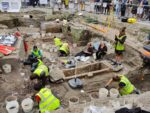 Excavations at the Church of Our Lady in the heart of historic Bruges, Belgium, have unearthed three medieval burial vaults, two of them with painted interior walls. Archaeologists have been excavating the former Onze-Lieve-Vrouwekerkhof cemetery under the Mariastraat, the street in front of the church, since mid-May to recover remains and artifacts before construction of an underground pumping station. Within days the skeletal remains of about 50 individuals were uncovered along with coffin nails from the simple wooden boxes, now decomposed, in which they were interred.
Excavations at the Church of Our Lady in the heart of historic Bruges, Belgium, have unearthed three medieval burial vaults, two of them with painted interior walls. Archaeologists have been excavating the former Onze-Lieve-Vrouwekerkhof cemetery under the Mariastraat, the street in front of the church, since mid-May to recover remains and artifacts before construction of an underground pumping station. Within days the skeletal remains of about 50 individuals were uncovered along with coffin nails from the simple wooden boxes, now decomposed, in which they were interred.
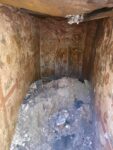 The first two masonry vaults were discovered less than a week into the excavation. One of them was richly decorated with painted murals on the interior walls. Both long sides of the rectangular vault feature angels swinging censers so vigorously they’re horizontal. The short end at the head of the fault is a scene of Calvary — Jesus crucified with his mother Mary standing to his right and the apostle John on his left. Copious blood pours from the nail holes in his hands and feet and from the
The first two masonry vaults were discovered less than a week into the excavation. One of them was richly decorated with painted murals on the interior walls. Both long sides of the rectangular vault feature angels swinging censers so vigorously they’re horizontal. The short end at the head of the fault is a scene of Calvary — Jesus crucified with his mother Mary standing to his right and the apostle John on his left. Copious blood pours from the nail holes in his hands and feet and from the 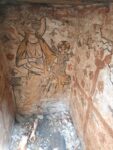 gaping spear wound in his side. At the foot end is a Sedes sapientiae, Mary enthroned with her arm around the child Jesus by her side. The main figural pieces on all four walls are sprinkled throughout with red flowers and red crosses bottony (a square cross with skinny arms that terminate in trefoils). Based on the painting style, the tomb has been dated to the late 14th century.
gaping spear wound in his side. At the foot end is a Sedes sapientiae, Mary enthroned with her arm around the child Jesus by her side. The main figural pieces on all four walls are sprinkled throughout with red flowers and red crosses bottony (a square cross with skinny arms that terminate in trefoils). Based on the painting style, the tomb has been dated to the late 14th century.
The third burial vault was unearthed last week. Its painted interior walls are very similar in style and motif, with angels wielding censers on the long 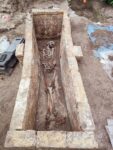 sides peppered with florals and crosses. The short side at the head also features a scene of the Crucifixion, Jesus on the cross flanked by Mary and John, while a Sedes sapientiae decorates the opposite short wall. This tomb also dates to the 14th century, but is likely a little younger than the previous find.
sides peppered with florals and crosses. The short side at the head also features a scene of the Crucifixion, Jesus on the cross flanked by Mary and John, while a Sedes sapientiae decorates the opposite short wall. This tomb also dates to the 14th century, but is likely a little younger than the previous find.
When these vaults were built, they were rush jobs. At that time, bodies had to be buried within 24 hours of death, so bricklayers, masons, plasterers 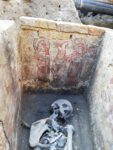 and painters had to make and decorate a vault with a quickness. Because the lime plaster never had the time to dry, the murals painted on the inside were basically frescoes, although not a deliberate choice so much as the exigencies of the situation. The condition of the paint can therefore be challenging. The murals in the first vault discovered are better conserved than the second.
and painters had to make and decorate a vault with a quickness. Because the lime plaster never had the time to dry, the murals painted on the inside were basically frescoes, although not a deliberate choice so much as the exigencies of the situation. The condition of the paint can therefore be challenging. The murals in the first vault discovered are better conserved than the second.
To ensure the best possible preservation of the painted burial vaults, archaeologists called in specialist conservators to clean and stabilize the 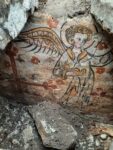 artworks as quickly as possible so they can be thoroughly photographed and documented. The crypts were then covered back up carefully to prevent damage from the elements. They will remain covered as long as they’re in situ. When the excavation is complete, the vaults will be lifted in their entirety and removed for conservation and study.
artworks as quickly as possible so they can be thoroughly photographed and documented. The crypts were then covered back up carefully to prevent damage from the elements. They will remain covered as long as they’re in situ. When the excavation is complete, the vaults will be lifted in their entirety and removed for conservation and study.
A 3D model of the first painted vault has already been completed (see below). A model of the second is in the works. This will allow people to see the vaults and conservators to assess their immediate condition needs without risking any damage to the delicate surfaces.